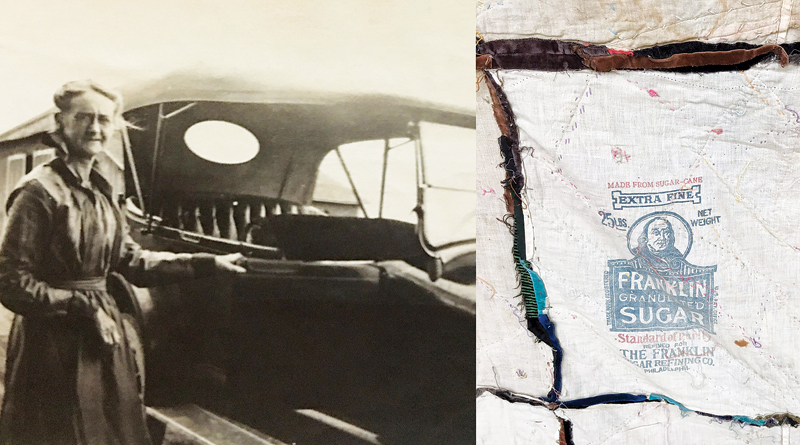MARGARET PROPHET & HER SUGAR SACK QUILT BACK – Around The Frame

Recently I went to a garage sale promoted for people interested in fabric, sewing or quilting items: No one else need come. I was intrigued by the classified and figured it would be worth a stop. Not only did I purchase lots of quilt quality fabric, I got to view an interesting crazy quilt made by a relative by marriage of one of the women hosting the sale. The front was made of colorful velvets and needlework and was in great shape considering its long life. The back was just as interesting because the maker used sugar sacks as her base fabric and rather than adding another piece of fabric to cover it up, left it for all to see.
Margaret Prophet who was born October 12, 1863 in Shenandoah Valley, Virginia during the Civil War made the quilt. At the age of five her family moved to Allen County Indiana where she lived the rest of her life.
Margaret married Winfield Scott in Monroeville, Ind. on August 28th, 1881. Margaret was a home maker with nine children. One of her daughters was Ida Pearl who always went by Pearl and was born November 27, 1896. After Margaret’s death on February 27, 1934 the quilt was passed down to Pearl (Scott) Dennis (husband Oscar Floyd Dennis) and then to her son Norman Dennis (wife Arlene Dennis) who then passed it to his son Milt Dennis (wife Peggy Dennis). The quilt now resides in Peggy’s quilting studio. Peggy considered adding a back fabric but decided the exposed sugar sacks made for a more interesting back.
Many quilters are familiar with feed/flower/sugar sacks because the Great Depression and WW II women would use them to make dresses, aprons, shirts and kid’s clothes. When the mills caught on to what they were doing, they started printing them in colorful patterns as a marketing ploy to entice people to purchase their particular brand.
Sacks used for sewing purposes is much older than the mid-1920’s. Going back a few centuries, food, animal feed, grain etc. were shipped in tin boxes and wood barrels: the tin would rust and the barrels would leak damaging their contents. Their weight also made them expensive and a challenge to transport. In 1846 sewing machine technology made it possible to sew double locking seams strong enough to create canvas bags big and sturdy enough to safely and more economically transport many products. Many of the logos on the sacks are round as they hearken back to the days when the logo had to fit on the top of a barrel.
Margaret’s sugar sacks are from the Franklin Sugar Refinery in Philadelphia. At its zenith, this refinery controlled 90% of the U.S. sugar. By 1900 there were 117 chocolate and candy manufacturers in the city where the likes of Whitman and Hershey got their starts. America’s oldest candy shop is Philly’s Shane’s Confectionary established in 1863, the same year Margaret was born. Now how sweet is that? So now when Peggy gazes at those Franklin sugar sacks backing Margaret’s quilt, she can ponder not only Margaret’s needle skills but the great Franklin Sugar Refinery who back in its day was responsible for so many cavities too! For more information on Philadelphia’s storied chocolate/candy history go to: billypenn.com/2015/10/30/how-philly-and-pennsylvania-grew-to-dominate-the-candy-industry/
- Sewing For A Higher Purpose ~ Around The Frame - April 12, 2024
- National Quilting Day 2024 ~ Around The Frame - March 1, 2024
- Reunited! ~ Around The Frame - February 2, 2024


